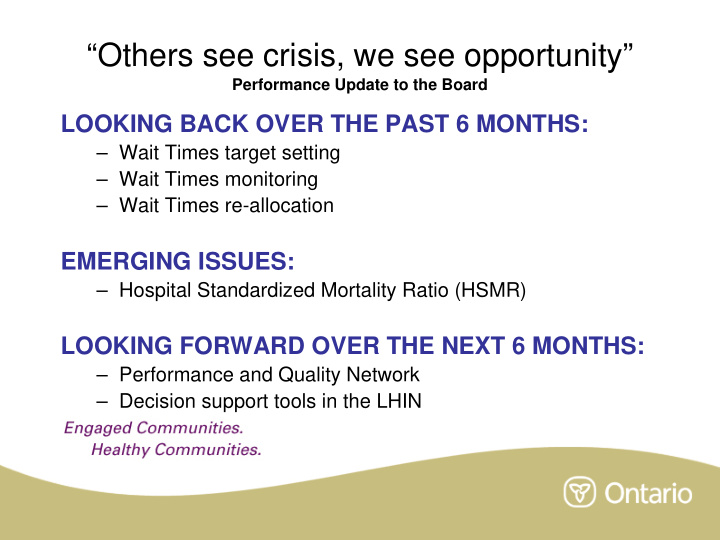



“Others see crisis, we see opportunity” Performance Update to the Board LOOKING BACK OVER THE PAST 6 MONTHS: – Wait Times target setting – Wait Times monitoring – Wait Times re-allocation EMERGING ISSUES: – Hospital Standardized Mortality Ratio (HSMR) LOOKING FORWARD OVER THE NEXT 6 MONTHS: – Performance and Quality Network – Decision support tools in the LHIN
Waiting Times The Concept, Problem & Solution
Background & Concepts • Queuing theory studies the factors affecting waiting times for a service (ie., retail, health, etc) • The premise of Queuing theory is: “with random arrival rates of customers, waiting lists will emerge” • That is, if customers are allowed to arrive for their service randomly, queuing theory predicts they will wait a given time for service
Background & Concepts • To manage a wait list, we therefore need to predict or control arrival rates or demand for service • To avoid a wait list, we need to smooth capacity for service delivery to manage demand for service
Issues to consider • Managing wait times in health care can create perverse incentives (e.g, longer- waits, more money) • Creating too much capacity to manage demand results in un-used capacity which is wasteful in an environment of fiscal restraint
Conflicting Perspectives • Patient: Demand = Capacity • HSP: Demand > Capacity
LHINS The role for LHINs in managing wait times is: to predict demand and smooth capacity
Solutions: Our Orthopaedic Assessment Centre Current Referral Process OAC Referral Process Central Intake and Assessment BEFORE AFTER
Central East LHIN Activities to date • PDSA Quality Improvement Cycle: Plan, Do, See & Act • Understand & clarify capacity among HSPs (e.g., hospital forecasts, incremental volume discussions) • Predicted demand via models • Targets negotiation • Execution & re-allocation
Annual Performance Goal Recap
Recommend
More recommend